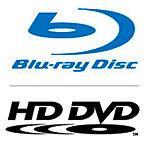
by Steven Castle - June 2006
|
Related Articles from Electronic House |
| Comming Soon: High Definition DVD Rentals |
| Movies Available in High Definition DVD |
| The Latest High-Definition DVD Players |
The high-definition DVD battle is on! We analyze the ins and outs of the two competing formats.
In the battle between HD DVD and Blu-ray, we really can't tell you which one will win, because we don't know. We can't even tell you which one is better. Besides, the "better" one doesn't always win (see Betamax vs. VHS). All we can give you is the information to (hopefully) make a wise buying decision.
Both new formats are the same size as today's DVDs and will be backwards compatible with standard DVDs, meaning you can play a standard DVD in the players. Prices for the new discs will likely range from $30 to $40.
Players for both formats read the discs with a blue laser instead of the red one now used in standard DVD players. (Without the Science Channel explanation, suffice it to say that the blue laser allows for more information to be packed on the discs.) So HD DVD is "blue" like Blu-ray, while a Blu-ray Disc is a high-definition DVD, just like an HD DVD.
Both formats can show movies in super-high 1080p resolution, which is better than other high-definition resolutions like 1080i or 720p and far better than a standard DVD's 480 lines. (Although first-generation HD DVD players will display only up to 1080i; see "High Definition DVD Players" for more information.) Both formats will support several different soundtrack technologies like Dolby Digital and DTS Digital Surround, as well as the newer eight-channel Dolby TrueHD and DTS-HD for even better surround-sound experiences (eventually). Both will have easy-to-access menus that overlay on the movie image so you don't have to stop the movie to adjust a setting or check something out. Both have the potential for more bonus features like directors' commentaries with a picture-in-picture of the people talking. And in the future, there will be interactive features like games and web access via Internet connections, which should make bonus material far better than the lame extras we get with most standard DVDs. And that's about where the similarities between HD DVD and Blu-ray end.
HD DVD is backed by Toshiba, NEC, Sanyo, Microsoft, Intel, the DVD Forum and some others. Blu-ray is backed principally by its developer, Sony, with support from Panasonic, Samsung, Pioneer and a slew of others.
HD DVD movies are being released by Warner Home Video, Paramount, Universal, European company Studio Canal and the Weinstein Company (from the founders of Miramax Films). Blu-ray, meanwhile, has support from seven of the eight major studios: Sony Pictures, 20th Century Fox, Disney, Warner Home Video, Paramount, Lionsgate and MGM. Warner and Paramount are supporting both formats, and Disney has made noise about doing the same.
An HD DVD is a double-layer disc that can hold 15 GB per layer, or a total of 30 GB, while Blu-ray can hold 25 GB per layer for a total of 50 GB. (A standard DVD, by comparison, stores only 4.7 GB on a single layer and 8.5 GB in dual layers.) An HD DVD can store four to eight hours of high-definition video (about four hours per layer), while Blu-ray can hold more than nine hours of HD on a dual-sided disc.
On the surface, it appears as if Blu-ray has the clear advantage. It holds more data, in theory it is more robust and, perhaps most important, it has more support from the Hollywood studios that put out the discs. No brainer: Blu-ray wins, right?
But it's not so simple. First of all, HD DVD was launched first, in April, while Blu-ray has hit some snags and as of this writing was scheduled to be launched in late May. (If it hasn't launched by the time you read this, then there may have been further delays.) Blu-ray's setbacks include Sony's postponement until November of its PlayStation 3 game console, which is to contain a Blu-ray player. And in April, Samsung announced it was delaying its Blu-ray player until June because it needed more time to test the Blu-ray Discs. Blu-ray Discs won't be capable of using dual layers right away, meaning that the early versions will have less capacity than HD DVDs. Blu-ray is also behind on features such as picture-in-picture.
And while HD DVD is considered an "evolution" of the DVD format, Blu-ray is "revolutionary," by Sony's admittance. That may make Blu-ray more robust than HD DVD, but it also makes producing the discs and the players more technically challenging and expensive. Price may not mean much to eager early adopters, but the fact that Toshiba's entry-level HD DVD player is $499, while the Blu-ray players will run $1,000 and up, may prove in the long run to be more than a marketing statement. Also, do you want to bet against HD DVD when Microsoft and Intel are throwing their weight behind it?
How do the movies look? Only when both formats are available will experts have enough experience viewing each to even think about declaring which is better. But let's put it this way: Both can show movies in 1080p resolution, which is better than regular HD and blows away standard DVDs.
We can spout about gigabytes and who has the best technology and pricing, but one thing that most everyone agrees on is that content is king. What movies are available in each format may well determine a front-runner. And it appears Blu-ray has the edge with its deeper movie studio support. But if this format war goes on for two or three years as expected, look for virtually every major studio to support both, with the exception of Sony Pictures, due to Sony's development of Blu-ray.
Steven Castle is a Senior Editor and the resident wit of Electronic House magazine. Email Steve at [email protected].




